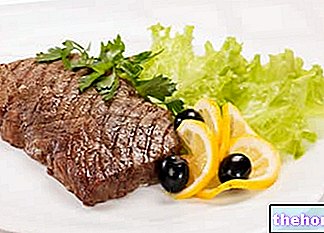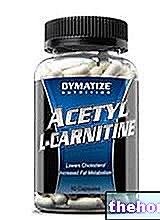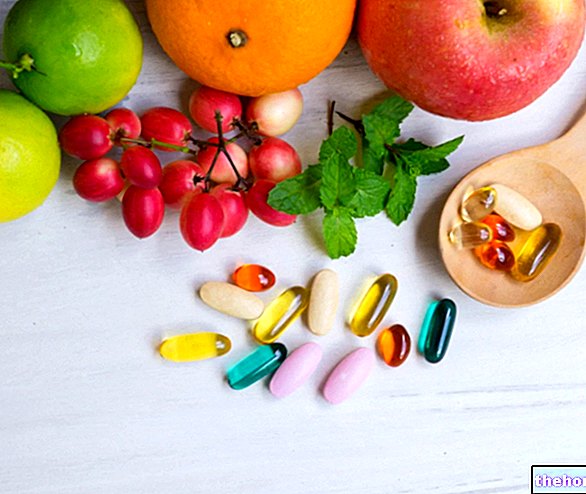See also: phytoestrogens
Isoflavones belong to the category of phytoestrogens, substances of plant origin structurally and functionally similar to estrogens produced by the organism (in particular by the female one, since the male one produces limited quantities). The isoflavones, although presenting a "high affinity" towards estrogen receptors, they possess a very weak "estrogenic activity, about 1,000-10,000 times lower than their endogenous counterpart (estradiol). We can therefore compare phytoestrogens to wrong keys which, despite managing to get stuck in a certain lock, do not succeed The fact that the key is inserted but cannot turn (isoflavone / estrogen receptor binding) prevents the appropriate key (estrogen) from entering the lock, blocking the action of these hormones.
All these properties, common to isoflavones and other phytoestrogens, have a double benefit for the female organism.
Antitumor activity of soy isoflavones
In childbearing age, isoflavones balance the activity of estrogens produced by the body, protecting it from some cancers, such as breast cancer, more frequent in women with high levels of these hormones.

Among the various researches that have reduced the enthusiasm for soy and its isoflavones, the most important have been carried out in countries where the incidence of the aforementioned forms of cancer is lower. In China, where soy consumption is one third of that in Japan, the incidence of breast cancer is equally low. Another study showed that Japanese women with breast cancer consumed similar amounts of soy to the rest of the population. For this reason the anticancer properties of soy are not yet certain.Moreover, it is really difficult to demonstrate that a single substance or food has beneficial effects on a disease with such a significant social weight and on whose development countless genetic, environmental and behavioral factors affect.
Isoflavones in menopause
Many women who refuse HRT use isoflavones as a remedy for hot flashes. These substances, mimicking the activity of estrogens, sharply decreased following menopause, also have an effective protective action against osteoporosis and cardiovascular diseases. Therefore, while in fertile age the beneficial effect of isoflavones derives above all from their antiestrogenic properties, after menopause their estrogen-like properties are particularly useful. This double function, apparently contradictory, depends on the hormonal environment in which they act (estrogenic levels very high in childbearing age and very low after menopause).
Isoflavones in food
Isoflavones are found mainly in soybeans and other legumes (such as chickpeas, lentils and broad beans), red clover, whole grains and fennel.
The main isoflavones present in soy are genistein (about 70%), daidzein (about 25%) and glycitein (about 5%). These phytoestrogens can be found both in free and glycosylated form (genistin, daidzin, glycicin), that is, linked to a sugar. In order for these glycosides to work, they must be hydrolyzed by an enzyme produced by the intestinal flora, whose effectiveness is enhanced by a diet rich in prebiotics. The latter, mainly present in vegetables (chicory, garlic, artichokes, bananas, leeks, asparagus, whole grains) and marketed as dietary supplements (inulin, FOS), favor the balance of the intestinal bacterial flora, stimulating the activity of the good strains at the expense of the bad ones.
MORE: Isoflavones in food, supplements "
Select plant Fir Acacia Acerola Sorrel Yarrow Yarrow Yarrow Aconito Adatoda Garlic Agnocasto Agrimonia Alchemilla Alkekengi Aloe Altea Witch Hazel Ammi or Visnaga Pineapple Andrographis Anemone Pulsatilla Angelica Anise Star Anise Japanese Star Anise Bitter Orange Bitter Areca Arnica Harpagophytum Arpagophyte Artemisia Asteragus Basil Asparagus Asparagus Peruvian Asparagus Asparagus Asparagus Hawthorn Boldo Borage Shepherd's Purse Boswellia Bucco Butea superba Cocoa Coffee Cajeput Calamus Calamus Marigold Camedrio Chamomile Roman Chamomile Camphor Cinnamon Ceylon Maidenhair Capuchin Artichoke Cardamom Cardiac Thistle Asian Thistle Carvi Cascara Cassia Catecu Catha Cabbage Celandine Chicory Centaurea Cinnamon Cypress Celandine Chives Cypress Coca Cola Colchico Combreto Condurango Comfrey Coriander Cranberry Barberry American Chrysanthemum Cumin Turmeric Damiana Digital Dioscorea Drosera Dulcamara Dunalilella Echinacea Eder a Ephedra Elenio Eleutherococcus Helichrysum Evening primrose Horsetail Alfalfa Erica Euphrasia Erisimo Escolzia Eucalyptus Farfara Farfaraccio Calabar bean Fenugreek Fennel Phytolacca Frangola Ash Fumaria Japanese Mushrooms Galega Ganoderma lucidum Garcinia Cambogia Mulberry Gentian Broom Ginkgo Ginkgo Guipana Guipana Gynestra Ginkgo Hibelia Gymnasium Hibiscus Guarulp St. John's Wort Horse Chestnut Ispaghul Hyssop Jaborandi Kava kava Konjac Laminaria Cherry Laurel Lavender Lemongrass Lespedeza Lovage Icelandic Lichen Lemon Flax Lippia Licorice Lobelia Hops Maca Marjoram Maize Mallow Manna Marrubio Marrubio d "water Matè Melaleuca Meliloto American Lemon balm Myrtle Myrama Walnut Nutmeg Walnut vomica Olive tree Meadowsweet Ononide Opuntia Oregano Orthosiphon Nettle Poppy Papaya Parietaria Feverfew Passiflora Chilli Perilla Periwinkle Phyllanthus Plantain Picrorhiza Pilosella Pino Pisci dia Podofillo Polygala Grapefruit Parsley Psyllium Pueraria mirifica Butcher's broom Pygeum Quassia Oak Rhubarb Ratania Rauwolfia currant Castor bean Rhodiola Rosehip Rosemary Rue Willow Sarsaparilla Sage Elderberry Sassafras Sedum Ergot Senna Serenoa Repens Soybean Solidago Tansy Taraxus Tamarind Tamarind Tamarind Tamarind Tamarindo Ursina Valerian Vanilla Mullein Verbena Veronica Viburnum Vinca Pansy Mistletoe Vine Withania Yohimbe Saffron Ginger Pumpkin Select disease Juvenile Acne Rosacea Tinnitus Tinnitus Aerophagia Tendon Affections Afonia Aphthae Algias Functional Halitosis Breastfeeding Allergy Anemia Anguish Anxiety Arteriosclerosis Asthrosis Asthrosis Arthritis Arthritis Men Sex Woman Blepharitis and Conjunctivitis Eye bags Bronchitis Gallstones Kidney stones Salivary stones Baldness Androgenetic Candida Fragile hair Caries Headache Cellulitis Motion sickness Cystitis C limaterio Cholecystopathy High cholesterol Ulcerative colitis Colonoscopy Contusions Hematoma Convalescence Couperose Depression Dermatitis Diaper dermatitis Diabetes Diarrhea Erectile dysfunction Dyslipidemia Dysmenorrhea Dyspepsia Disturbances of vision Hemorrhoids Epistaxis Herethism Heart disease Fever Fibromyalgia Gastro-intestinal disease Flatulence Hypertension Fibromyalgia Gastrointomnia Jaundice Laryngitis Renal lithiasis Toothache Sore throat Thinness Menopause Meteorism Mononucleosis Alzheimer's disease Crohn's disease Nausea Vomiting Obesity Dark circles Onychomycosis Osteoporosis Dry skin Periarthritis Piorea Low pressure Prostatitis Psoriasis Colds Breast fissures Anal fissures Gastro-nasal rhinitis Senescence Premenstrual Syndrome Sinusitis Quit smoking Overweight Fatty liver Constipation Stomatitis Stress Cough Triglycerides high Ulcer Burns Nails Brittle flashes Heat Warts Dizziness Properties herbal Tanning Abortive adaptogenic Aphrodisiac bittering analgesic anesthetic anorectics analgesic antacid anti-allergic anti-asthmatic Antibiotic catarrh Anticellulitiche anticonvulsant Antidiaforetiche antidiarrheal edematous anthelmintic antiemetic Antiemorroidarie antiphlogistic Antiidrotiche Antinevrotiche Antioxidants antipyretic antirheumatic antiscorbutic Antiseptic antispasmodic anti-uric Aperitive Flavoring Astringent Balsamic Bechiche Capillarotrope Cardiotonic Carminative Cathartic Caustics Healing Cholagogues Choleretic Dyes Decongestants Deodorants Purifying Diaphoretic Cleansers Disinfectants Detoxifiers Thirst quenching Diuretics Exciting Emetics Emmenagogues Emollients Hemostatic Energies Hepatoprotectors Expectorants Eupepticus Moisturisers Galactosensitizers lanti Hypertensive Hypnotic Hypoglycemic Hypotensive Irritants Laxatives Soothing Narcotic Nerves Nutrients Odontalgic Pectoral Purgative Revulsive Remineralizing Refreshing Rubefacient Scialagoghe Sedative Soporifugas Sneezing Stomachic Stomatics Narcotic Vascular Tightenitis



























